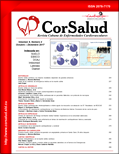Therapeutic hypothermia in resuscitated cardiopulmonary arrest
Abstract
Introduction: Applying hypothermia in the first hours to a comatose patient who has survived cardiopulmonary arrest helps minimizing brain injury and improves survival.
Objective: To determine the use-effectiveness of therapeutic hypothermia after cardiac arrest.
Method: Quasi-experimental research on hospitalized patients in the Intensive Care Unit at the «Hospital Arnaldo Milián Castro» in Santa Clara, Cuba, between January 2013 and September 2015. The sample consisted of 26 patients: 13 treated (study) and 13 non-treated (control). Variables studied were: age, sex, arrest scenario, comorbidities and Glasgow coma scale (on admission, during neurological recovery at 72 hours and at discharge).
Results: No significant differences were found between both groups. The average age was 63 and 57 years, respectively. Male (more than 60%) and out-of-hospital arrest location predominated. Higher incidence comorbidities were: high blood pressure, heart disease and diabetes mellitus; as well as initial Glasgow coma scale score of 3 in both groups, often greater than 50%.
Conclusions: Therapeutic hypothermia-treated patients presented fewer neurological complications and lower mortality, despite having, in most cases, an initial non-shockable rhythm and longer arrest time.
Downloads
Downloads
Published
How to Cite
Issue
Section
License
Authors who publish with this journal agree to the following terms:- Authors retain copyright and grant the journal right of first publication with the work simultaneously licensed under a Creative Commons Attribution License that allows others to share the work with an acknowledgement of the work's authorship and initial publication in this journal.
- Authors are able to enter into separate, additional contractual arrangements for the non-exclusive distribution of the journal's published version of the work (e.g., post it to an institutional repository or publish it in a book), with an acknowledgement of its initial publication in this journal.










